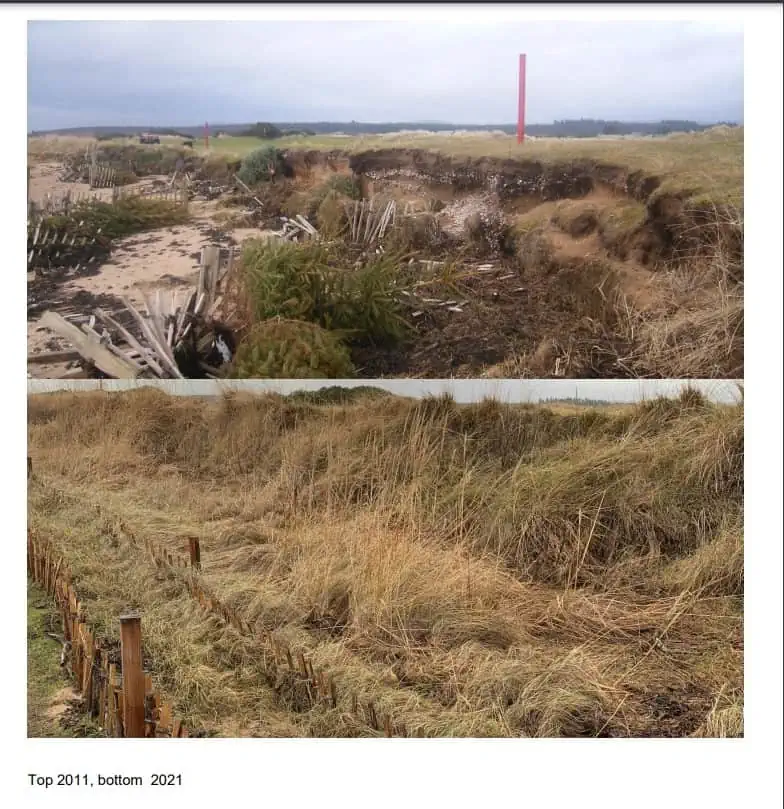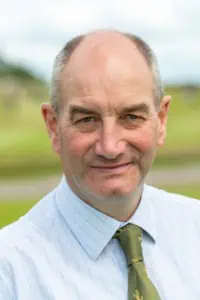Royal Dornoch: “All we ever did was mow the grass that was there”.
For many golfers worldwide, a golf trip to Royal Dornoch is almost like a pilgrimage. Golf in the town of Dornoch can be traced back to 1616, and the championship course ranks in the top 15 of the world’s best golf courses year after year.
In the Vision 2050 series, Royal Dornoch Golf Club plays a prominent role for us. On the one hand, it shows how golf can develop in a positive direction over the centuries and also play a central role in a town. But it also stands for all those golf courses that suffer from climate change, because scientists of the Dynamic Coast project, which studies the development of Scotland’s coasts, consider the Struie Course at Royal Dornoch to be at high risk of erosion.
Reason enough for us to talk to Neil Hampton, General Manager of Royal Dornoch Golf Club and strong advocate of a sound sustainability strategy for the club.
According to Dynamic Coast’s studies, the Royal Dornoch coast is under severe threat from erosion. When did you learn about this, and what feelings and reactions did it trigger?
Neil Hampton: We’re fortunate that one of our members, Alistair Rennie, works on the Dynamic Coast project, and he’s based in the area. He has lived and worked here, and he is a golfer, so he likes the golf course, and he wants to help the golf course. Five years ago, we talked about his work and how scientists predicted how things would change in the future. And he started us thinking about the future as it were 2050 or 2100. So, he was the catalyst for us.
What was the first reaction of you and the golf club officials? Were you shocked?
Neil Hampton: No. I think we are all reasonably intelligent people. We know that the world is changing, and climate change has been something that’s been around for a while. I just don’t think we realized how big a difference it would make to us. If the sea level rises by half a meter or a meter, where does that leave the golf courses? And what do we have to do? We are all aware the world is changing. We probably just put it to one side and hadn’t really thought about it too deeply, but we knew in the back of our minds it was there.
Obviously, the Struie course is the one, where you have to find solutions.
Neil Hampton: Yes, because that is the lower one. We had some erosion around that area and that’s where the conversation with Alistair started. He then showed us his work in Dynamic Coast and we had contact with St. Andrew’s University. They are investigating soft methods of keeping the sea at bay. All that added together was very interesting.
There are different approaches to stop erosions; why did you decide for the marsh project?
Neil Hampton: We have rock armor protection along parts of the championship course, but that was put in about 25 years ago when that was seen as the solution to everything, just for the waves to crash against it. Now we understand that we must break up the motion of the waves so that any impact that has the sea on the shoreline is a lot less. We put in that kind of chestnut fencing, as we call it. And that is just a way of us breaking up the wave’s energy, so it would deposit the sand, and the salt marsh would grow back in. Eventually, the fence will be redundant. And it’ll be the salt marsh itself that is doing the work for us.
So, how will Royal Dornoch as a golf club look in 2050?
Neil Hampton: I think we’ll still be in a very good position as a golf club and as a business. So confidently, we think over the next 25, 26, 27 years the championship course won’t vary much. We concentrate on the Struie course and what we can do with that.
We experience many discussions about the ecological input of golf and the use of land for golf courses in bigger cities in many parts of Europe. How do you see the future of golf and the links courses in Scotland in general?
Neil Hampton: I don’t think the position of golf in Scotland will change. Golf in Scotland is still seen as the place where the game started. And that’s why people want to come. Golf has been played in Royal Dornoch for over 400 years. That is a big part of history. People want to come and enjoy and see for themselves why the game exploded around the world. Why was it so much fun, and people wanted to take it everywhere else? I think golf in Scotland will still be very strong.
Did you imagine when you took up a job as general manager of a golf club, that you would also become an expert in things like coastal erosion?
No, I didn’t imagine that. When I first started this job, it was all about the golfing experience and making sure people did that. But now what we do is so much wider, and it’s a lot more fun. Everybody wants their job to be varied, you know, and have a different thing to do every day. It’s a lot about sustainability. For example recycling or the work with the Golf Environment Organization – all these things we’ve got involved in the last ten years have been wonderful. It helps me promote the game by showing that golf is good for the environment.
Looking back in history, golf didn’t need many resources. Does it make sense, to look back sometimes to get fresh ideas for the future?
Neil Hampton: Yes. I had a couple of discussions recently about the old days in the seventies and eighties when we saw golf on color TV. In my opinion, color TVs have been something good for the game and bad for the game because we saw the Masters in April and the bright green grass and the deep blue water and all these beautiful flowers, and people thought the game had to be like that everywhere. Now, we’ve managed to come full circle back to the fact that a course can be brown and yellow, and the fairways are firm. That is the way the game should be, and the less input we have, the better golfing experience we are going to get.
Is it a real strength of golf that it doesn’t need more than a bit of grass and water?
Neil Hampton: Yes, very much. When we look back and look for the answer to the original question why people came to Scotland to play golf, we see that all we ever did was mow the grass that was there. We didn’t import new grass or new seeds. We just said, here’s a piece of grass; let’s just cut it a little bit, manicure it and work with it. A lot of the conversations I’ve had about golf in the United States is that it is so manufactured and that they’re growing grass in the desert where grass never grew before. So that’s where the intensity of their golf production compares to the very light touch that we have here. I think that’s the way the game is going, and our team here is very conscious about only cutting what’s necessary to cut. This is a very basic approach, which is good. Besides we’re planting wildflower seeds in the outer play areas. We’ve got our beehives now; we’ve got our bug hotels. We’re trying very hard to show that. Whenever you are on the golf course, you’re very much close to nature. You’re not in a manufactured environment.
Adapting to climate change costs money….
Neil Hampton: That has never been a topic in Royal Dornoch. We want to invest in the future, and we want to have our own sustainability officer, somebody on the staff who’s going around making sure we’re doing everything the right way. And again, we can save money by doing that if we stop doing processes that are invasive or if we stop doing processes that are too intense for what we need to produce. For the next four weeks, we have a student from Stanford University here. She is analyzing our carbon footprint, and she will tell us what we can do to reduce that.
What is your long-term goal?
Neil Hampton: We want to be the number one golf club in the world for being sustainable and environmentally friendly. And if we get that right by employing somebody to look after it daily, we will do that. Then, we expect that we will save money in the processes that we put in place.
How is the normal club golfer reacting to all these projects?
Neil Hampton: I don’t hear any conversation in the golf club, at the bar, or on the golf course about the environment. These people are here to play and enjoy the golf course and have the best sport or the best experience.
One of the cornerstones of success is the interaction between the club and the whole society. How important is that for the future?
Neil Hampton: We’re in a small town, there’s only 1500 people that live here. You have to realize that everybody’s got a part to play in making Dornoch grow as a location, as a business, and as an economic environment. So the club had, through previous regimes, managed to separate itself, unfortunately, from the town. Part of what I did was to make sure we got back into the town and, what you’re seeing, the results of us being one of the town and not just the reason for the town. Now, I work on a lot of committees and boards in the town. We fund a lot of things. We make sure that the club is seen to be providing for the town in a way the town wants. Dornoch is a small location in the north of Scotland; it’s not a big metropolis. We know we have to work together.
Talking about the future, are you afraid of weather extremes like in other countries?
Neil Hampton: We didn’t have the extremes of weather like others until now. As a small island and being the north of a small island, we’ll get a bit of wind, we’ll get a bit of rain, but we don’t get the things that I see in the United States, for example, these huge thunderstorms. So, I think Scotland is the best environment for golf to be played. Are we frightened of the future? No. I think we’ve been fortunate to be where we are. We get lots of rain. We get a nice bit of sunshine. We’re fortunate that, again, back to golf being Scotland’s game because this is the best place to do it.









